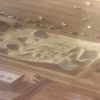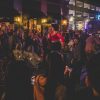The History of Heat Wave Skate Park
by Marc “Squid” Johnson
The skatepark was designed by San Francisco skater Dan DiPaola and financed by a group associated with Beno’s Department Store out of Southern California. Dan combined design elements of several successful SoCal skateparks and was responsible for inventing the Mogul Bowl, a large triangular bowl surrounded by sloping banks with four strategically placed cement moguls in the middle which allowed skaters to ride around the bowl and over the moguls while applying pressure to the tail of the board in order to pick up speed , carrying inertia and ricocheting around the bowl indefinitely. This soon became the most attractive feature of the skatepark, fostering a fast learning environment and along with the spontaneous nature of skating, occasional collisions. The bowl design was pure genius and caught on as a skatepark design staple worldwide.
The official grand opening was September 17, 1977. The park had been unofficially open since late July 1977 and was well attended, with skaters needing to purchase a “membership” which included a laminated photo card and a signed insurance waiver. A fully stocked Pro Shop offered state-of-the-art skateboards and components as well as safety gear and coveted skate logo t-shirts. The Heat Wave was the first shop for miles (as well as for several years) to sell Vans Off The Wall skate shoes which came in two tone red and blue (I bought the first pair).
There was a contest on opening day which was attended by skate teams from all over California including the infamous Tunnel Team, the Santa Cruz team, the Alot-A-Flex team from Berkeley as well as the uncanny talent of Barron Ealoha from San Francisco who jumped out of a bowl and over a Honda Civic. The contest was won by Gary Kocot of the California Free Former team who finished his routine by impressing the judges with a handstand across the flat part of the bowl, much to the dismay of his competitors who adhered to a strict bowl riding standard of tricks on banked walls and various aerials.
At some point BMX bikes were invited into the park, many of the skaters being BMX jumpers and racers already. The bikes were particularly exciting, taking lines of their own as well as jumping about three times farther than the boards, and subsequently upping the level of carnage.
Injuries of various types were common but only infrequently severe. As one acquired greater skill, the falls generally became less frequent as well as less severe. If a skater had the presence of mind to begin rolling into a fall while still in midair, the consequences were sure to be less dire. Almost everyone came away with road rash on knees and elbows, falling some distance onto a hip was a given, with the occasional ankle sprain or concussion, tailbone injuries also, maybe even a Swellbow. The most common broken bone was a wrist, this park averaging maybe two or three a month, usually happening with the skater trying to protect himself while falling face first. The aforementioned roll prevented many a wrist injury. By far the most fearsome break was the femur, which could be heard from some distance away (I am aware of only two). If you were going to skate hard, you had to get used to road rash. To this day, every skater remembers the feeling of waking up with scabs stuck to the sheets, bleeding through the knees of your pants in school, or the dubious honor of sporting jerky on all four corners.
The park was also open during the winter months but was only lightly attended during cold weather, the banked and vertical walls growing dangerously slick in the Valley fog, and falling on concrete being even more painful when you were already cold. Rain days brought certain closure with the bowls often filling with up to twelve feet of rainwater due to famous Modesto drainage issues.
Subsequent years brought decreasing attendance with a small group of intrepid locals frequenting the park until closing, mainly due to high insurance costs and diminished attendance. The ownership finally closed in December of 1979, which stopped the cash flow but not the skaters. True skateboarding, being born of mischief, continued long after the official closure with local skaters jumping the fences at night and skating in the dark, no lights, often by memory alone. Soon the runs were draped by management with heavy chain, bolted to the concrete. Ironically the chains were placed by non-skaters who were unaware of the actual direction of travel, rendering the measures completely ineffective. Skating in the dark continued until the park finally fell to wrecking ball and bulldozer in the fall of 1982.












